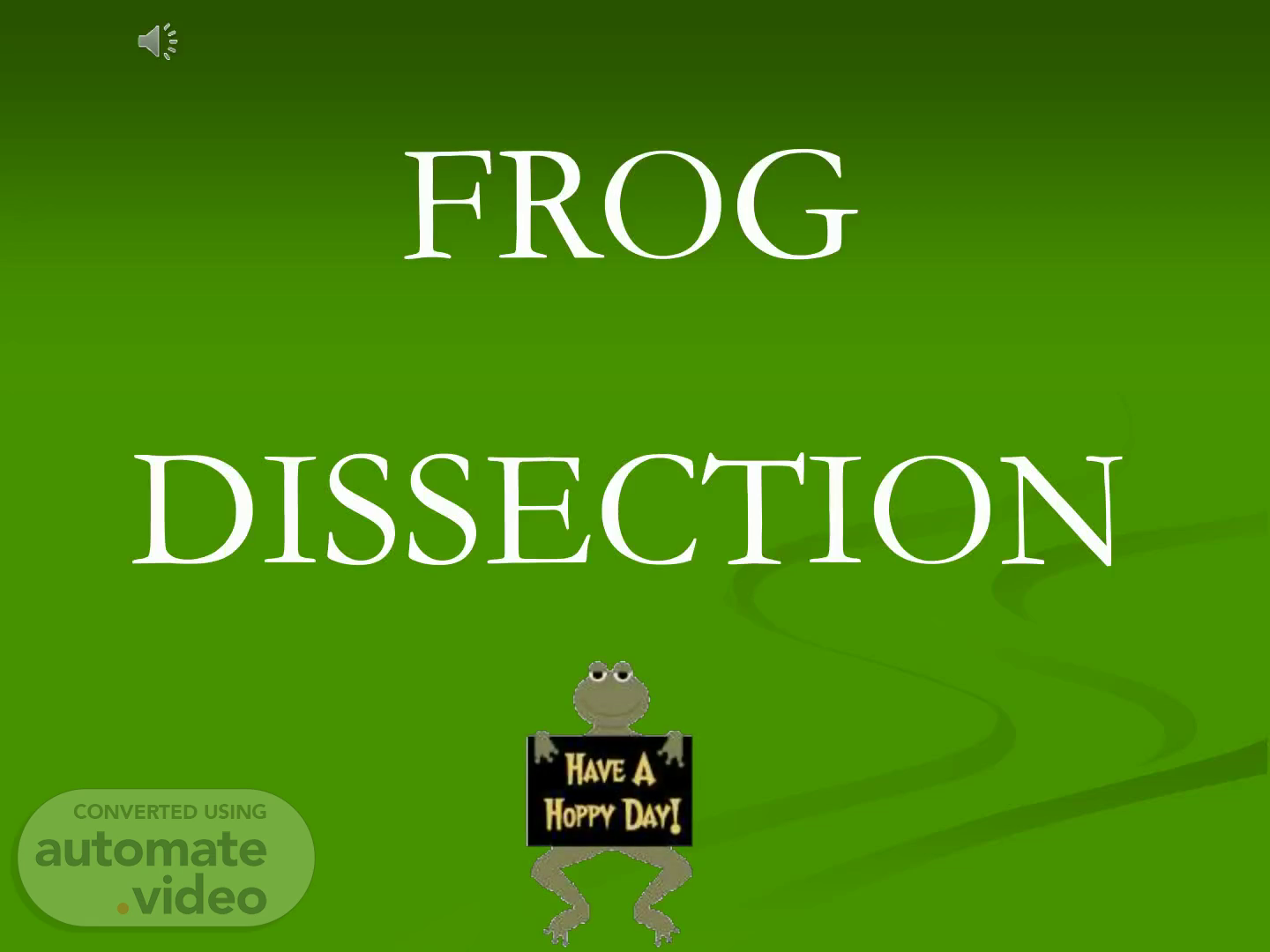Page 1 (0s)
. . V anvH. . . . . . Hoppy Dayl. FROG. DISSECTION.
Page 2 (9s)
. . . . . . . INTRODUCTION Dissection is the act of taking something apart for the purpose of examination. In this activity, you will dissect a frog. Like humans, frogs are vertebrates. Frogs have lungs, a heart, stomach and intestines just like us 0 Granted, a frog's.
Page 3 (42s)
. . . . . . . . Dissection. Familiarize yourself with this diagram so that you are able to identify organs.
Page 4 (54s)
. . — pancreas Spleen Large intestine. . . . Gau Bladder Skeleton Intestines ung Bladder ach reas.
Page 5 (1m 7s)
. . . . . . . . External anatomy. Explore the external anatomy of the frog by clicking on various parts of the frog and learning.
Page 6 (1m 20s)
. . . . . . . . .
Page 7 (1m 27s)
. . . . . . absorb oxygen from the water. T also prevents the frog from do nen it is out of the water and ry — helping it escape predators. skin may be covered in spots, matophores. You may also notic ump on the frogs back called the sacrum •.
Page 8 (2m 5s)
. . . . . . lembrane called the nictitating ine which protects the eye from 'hen the frog is submerged and t moistened when out of water. so have an ear, which is really a .ne which detects changes in air , similar to the human ear drum. nbrane is called the tympanum..
Page 9 (2m 41s)
. . . . . . . Nares These small slits are called external nares and allow a frog to float on the surface of the water and still inhale oxygen..
Page 10 (3m 2s)
. . . . . . )phagus, a tube where food es from the mouth to the Food is moved down the nagus by a process called which is coordinated contraction of muscles in )phagus. You'll also see the which is the opening to the . The glottis can prevent I objects from entering the.
Page 11 (3m 40s)
. . . . . . J's tongue is attached at ont of the mouth not the ar of the mouth as in .ns. Internal nares are on If of a frog's mouth and let nto the mouth from the xternal nares. When erged, they are closed to water from entering the lungs..
Page 12 (4m 13s)
. . •seslou. . . . small holes are the openings tympanum and are allow for ization of pressure on either of the tympanum. In some such as bullfrogs, they also the tympanum to act as an stic surface, helping frogs to ce their characteristically low noises..
Page 13 (4m 42s)
. . and serve to grip food tightly.. . . . The vomerine teeth are located between the nternal nares, and they serve to prevent the escape of prey. The maxillary teeth are comprised of a row of teeth along the outer border of the upper jaw and serve to grip food.
Page 14 (5m 10s)
. . . . . . mp up to six feet, the valent of human jumping a of 90 feet! To tell if your is male or female, look for a thumb pad on the forelimb indicates a male. This is etimes called a nuptial pad as it sts the male in massaging the ales abdomen to encourage the y to release eggs during.
Page 15 (5m 47s)
. . In males ana .4 females.. . . . . Cloaca Feces, urine, eggs.
Page 16 (6m 4s)
. . . . . . . Internal anatomy. Internal anatomy.
Page 17 (6m 12s)
. . secure your frog, then choose a tool an skin incision. You'll then need to carefu the muscle layer and pin that. .1.
Page 18 (6m 39s)
. . To begin the dissectio secure your frog, then skin incision. You'll the the muscle layer and p.
Page 19 (7m 3s)
. . To begin the dissectic secure your frog, ther skin incision. You'll th the muscle layer and.
Page 20 (7m 27s)
. . To begin the dissecti( secure your frog, ther skin incision. You'll th the muscle layer and.
Page 21 (7m 49s)
. . To begin the dissection you'll first secure your frog, then choose a tc skin incision. You'll then need to c the muscle layer and pin that..
Page 22 (8m 17s)
. . To begin the dissection you'll secure your frog, then choosi skin incision. You'll then neec the muscle layer and pin that.
Page 23 (8m 39s)
. . . . . . uctions: Internal anatomy Iin the dissection you'll first need to pir.
Page 24 (8m 57s)
. . . . . . . . Internal anatomy Instructions Click on an organ to learn about it, then remove it immediately to the organ tray. Begin with the fat bodies to allow you a better view of the organs. Then, explore each organ as you wish. If you prefer to follow instructions rather than explore on your own, click on the help function..
Page 25 (9m 15s)
. . to the organ tray. large, dark three-lobed organ) and the smal neath it. ch -the largest of the digestive organs. It has ;ually found on the left side of the body cavit and large intestines..
Page 26 (10m 5s)
. . . . . . [cn are on eltner slae ot tne deflated. the liver. ovaries which contain lacks these large egg an shaped organs. These arc e male..
Page 27 (11m 12s)
. . are wnen nanonng tne trogs. o learn. Ilow the directions carefully!.
